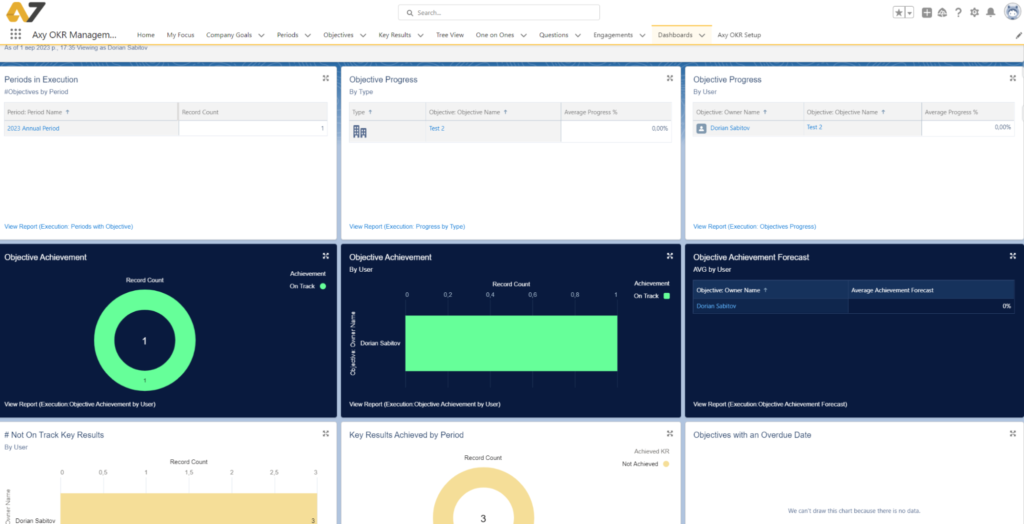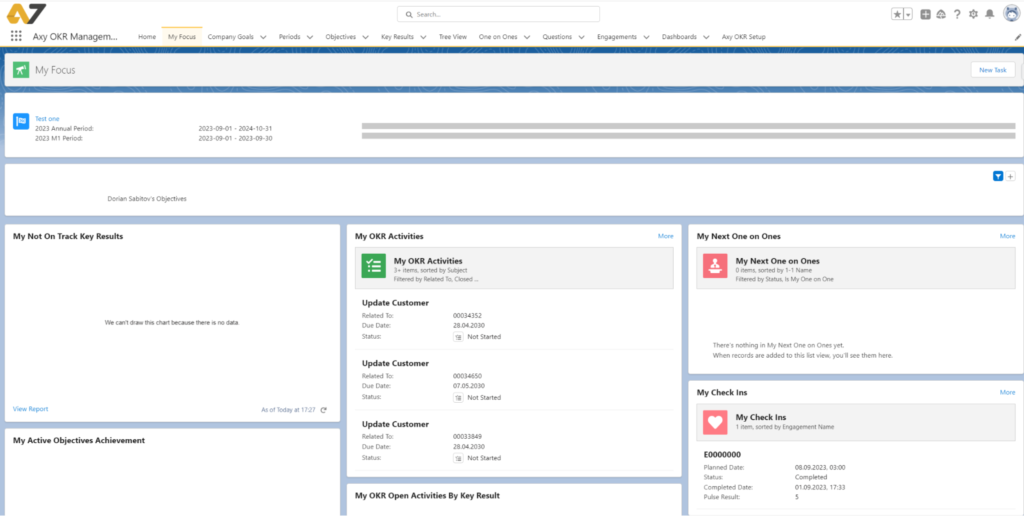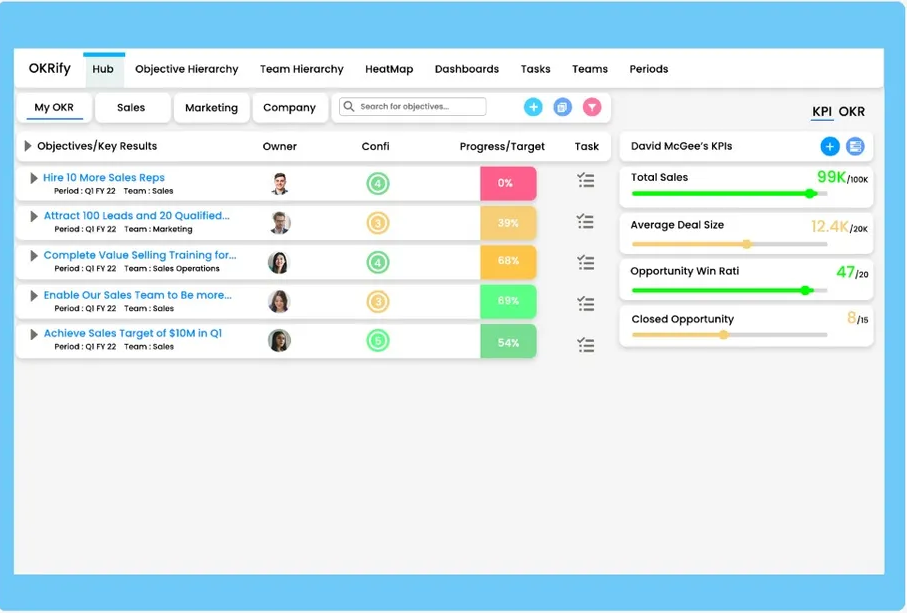
Unlocking Success with OKR
In the fast-paced world of business, setting goals and measuring progress is crucial for success. One framework that has been widely adopted by successful companies like Google, LinkedIn, and Twitter is Objective and Key Results (OKR).
Objective and Key Results (OKR) is a popular framework used by organizations to set goals, define key results, and track progress. Implementing OKR within your sales team can help to align the team’s goals, improve transparency, and drive better results. Salesforce, being a versatile CRM platform, allows the incorporation of OKRs, enhancing sales performance. This article will guide you through setting up sales team OKR in Salesforce, provide insights on advanced implementations using plugins, and recommend apps for different user needs.
What is OKR?
Objective and Key Results is a goal-setting framework that is used by teams and individuals to set clear, measurable goals. The framework consists of two components:
- Objective: This is a clear, qualitative description of what you want to achieve. It should be short, inspirational, and challenging.
- Key Results: These are a set of 2-5 quantitative measurements that help you track progress toward the objective. They should be specific, measurable, achievable, relevant, and time-bound (SMART).
Benefits of OKR
- Alignment: OKRs help in aligning the team’s goals with the organization’s objectives. This ensures that everyone is working towards a common goal, thereby driving collective efforts and ensuring better results.
- Focus: By defining clear objectives and key results, teams and individuals can focus on what is most important, avoiding distractions and ensuring better productivity.
- Transparency: OKRs promote transparency as they are usually shared openly within the organization. This helps in creating a culture of accountability and collaboration.
- Agility: OKRs are usually set for a short period (quarterly), which allows teams to adapt quickly to changes and stay agile.
- Engagement: Setting challenging objectives and achieving them boosts morale and engagement within the team.
Implementing OKR
- Understand the Framework: The first step in implementing OKR is to thoroughly understand the framework. It is essential to train the team and make sure everyone understands the concept of objectives and key results.
- Set Objectives: Set clear and challenging objectives for the team and individuals. It is essential to involve the team in this process to ensure buy-in.
- Define Key Results: Define SMART key results for each objective. Make sure they are measurable and directly contribute to achieving the objective.
- Track Progress: Regularly track progress towards the key results. It is essential to have regular check-ins (weekly or bi-weekly) to ensure that everyone is on track.
- Review and Reflect: At the end of the OKR cycle, review the progress made towards the objectives and key results. Reflect on what worked well and what didn’t, and use these learnings to set better OKRs for the next cycle.
Insight:
Common Pitfalls to Avoid:
- Setting Too Many OKRs: It is essential to focus on what is most important. Setting too many objectives and key results can lead to a lack of focus and suboptimal results.
- Not Measuring Progress: Regularly tracking progress toward the key results is crucial for success. Not measuring progress can lead to a lack of accountability and poor results.
- Not Aligning with Company Goals: Ensure that the OKRs set for the team and individuals are aligned with the overall company goals. This ensures that everyone is working towards a common objective.
- Setting Unachievable Key Results: While it is essential to set challenging objectives and key results, it is also important to make sure they are achievable. Setting unachievable key results can lead to frustration and demotivation.
App Recommendations
Axy OKR

Axy OKR is a performance management tool, designed exclusively within Salesforce, that facilitates OKR monitoring and assessment for enterprises actively utilizing Salesforce for their business functions. As an integrated part of Salesforce, Axy OKR offers numerous unique features, such as binding Salesforce reports for automated OKR progress tracking, which are not available in other OKR applications.




OKRify AI App

OKRify is a crucial tool for organizations utilizing Salesforce, with the goal of enhancing Goal Management and Strategy Execution. It is the singular tool that effortlessly combines OKR methodology with KPIs within Salesforce, thereby guaranteeing a dedicated and efficient execution of strategies. OKRify doesn’t only promote alignment, accountability, transparency, and collaboration among teams, but also offers a comprehensive and user-friendly platform, developed natively on Salesforce. It includes a wide range of features, from various levels of OKRs, Objective/Team Hierarchy, and Heatmap, to automatic updates on progress, real-time KPIs, milestones, divided period targets, and contributors, it addresses all aspects of OKR and KPI management thoroughly. In conclusion, OKRify functions as an essential central hub for the management, tracking, and updating of OKRs and KPIs, and for visualizing alignment throughout the organization, making it an essential application for organizations aiming for excellence and strategic alignment.



Insight:
- Ensure that the sales team OKRs are aligned with the overall company goals. This ensures that the entire organization is working towards a common objective.
- Regularly review the OKRs to ensure that they are still relevant and that the team is making progress.
- Be flexible with the OKRs. If a particular objective or key result is no longer relevant, don’t hesitate to modify or remove it.
FAQs on Setting up Sales Team OKR in Salesforce
How can I effectively track Sales Team OKRs using the Salesforce OKR Tracker?
To effectively track Sales Team OKRs using Salesforce, utilize the Salesforce OKR Tracker to set up and monitor both objectives and key results. Start by defining clear, measurable objectives linked directly to the team’s key results. Input these into the Salesforce OKR Tracker, which allows for setting up goals, assigning owners, and tracking progress over time. Ensure each key result has specific metrics that can be measured directly within Salesforce, such as revenue targets, number of deals closed, or lead conversion rates. Use the dashboard feature to visualize progress and performance against these OKRs in real-time. Regularly update the status of each OKR in Salesforce to keep the team aligned and focused on the most important outcomes.
What are some examples of effective OKRs for Sales Teams?
Effective OKRs for Sales Teams often focus on growth, efficiency, and customer satisfaction. For instance, an objective to increase market penetration in key segments might have key results targeting a 25% revenue growth in the healthcare sector by Q4 and securing three enterprise-level accounts each quarter. Another objective to improve sales efficiency could aim to reduce the sales cycle time by 15% by the year-end and increase sales per representative by 10% per quarter. For enhancing customer satisfaction and retention, objectives might focus on achieving a 90% customer satisfaction score and boosting customer retention rates by 5% in the next fiscal year.
How do I create a dynamic OKR Dashboard in Salesforce for Sales Teams?
To create a dynamic OKR Dashboard in Salesforce for sales teams, start by creating and customizing a new dashboard specifically for OKRs. Incorporate visual components such as graphs, gauge charts, and progress bars to represent each objective and its key results. Configure the dashboard to display real-time data concerning sales metrics like closed deals and revenue, ensuring it’s always showing the most current information. Make the dashboard accessible to all team members and set it to refresh at regular intervals or upon each login for the latest updates. This approach helps in keeping the sales team aligned and motivated.
What are the best practices for setting Sales OKRs to drive team performance?
When setting Sales OKRs, ensure they are aligned with the broader company objectives to keep everyone focused on what’s important. OKRs should be specific, measurable, and time-bound, with clear success definitions. Engaging the sales team in the OKR setting process ensures commitment and realism in the goals set. While OKRs should be challenging, they also need to be achievable to keep the team motivated. Implement regular check-ins to review progress and adapt to changes, and celebrate successes to maintain morale and motivation across the team.
Conclusion
Integrating OKRs for your sales team within Salesforce can drastically improve campaign statistics Salesforce and synchronize the team’s objectives with the company’s overarching goals. Begin by deploying basic functionalities, then progress to sophisticated implementations using plugins. A routine assessment of the OKRs, coupled with adaptability, will guarantee success.

Dorian is a 6X Certified Salesforce Developer and Administrator with a start in the IT world as a CRM Admin in 2020. Since diving into Salesforce in 2021 via Trailhead and Focus on Force, he has achieved a Ranger Rank, earned several Superbadges, and bagged certifications including the Salesforce Certified Administrator, Platform App Builder, Associate and Platform Developer I by 2023. In 2024 he also became Salesforce Certified AI Associate and earned Certified AI Specialist Certification in 2025. Dorian is very keen on continuous learning, always looks for fresh ways to improve his knowledge. He enjoys running, boxing, kickboxing and reading diverse kinds of books in his free time.


 Previous Post
Previous Post Next Post
Next Post
I have a few tips for you, to overcome common pitfalls in OKR implementation, it’s crucial to set a manageable number of objectives to maintain focus. Regularly track progress towards key results to ensure accountability and make adjustments as needed. Align team OKRs with overall company goals to ensure everyone is working towards a common objective. Ensure that key results are challenging yet achievable to avoid frustration and demotivation. Regular check-ins and reviews help keep objectives relevant and allow for necessary adjustments, ensuring continuous alignment and progress.
Hope it helps,
Dorian